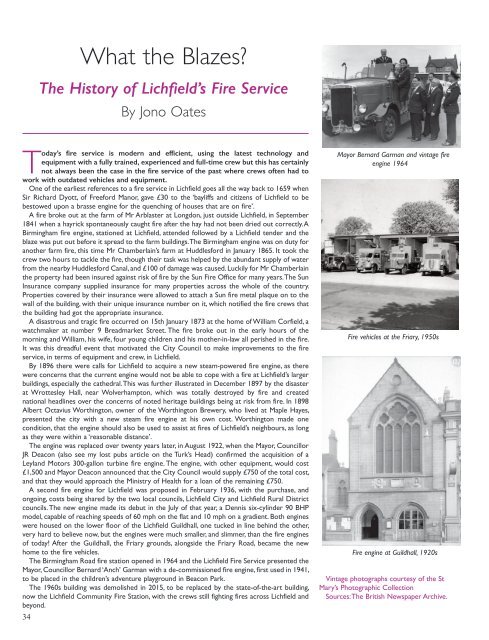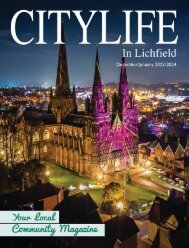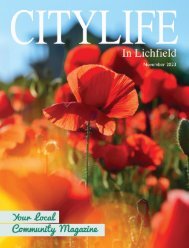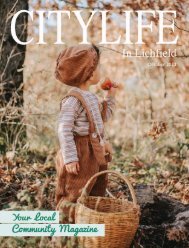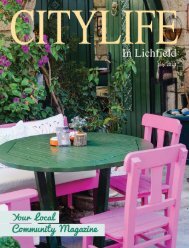Citylife in Lichfield September 2023
The month of September marks the change from Summer to Autumn, and in our September edition magazine we have our usual blend of local news stories, What's On events, local history and heritage features, recipes from our super chef Simon Smith, updates form our local council representatives and competitions. So, sit down with a large cup of latte, a slice of delicious cake and enjoy a read of our September community magazine this Autumn in Lichfield!
The month of September marks the change from Summer to Autumn, and in our September edition magazine we have our usual blend of local news stories, What's On events, local history and heritage features, recipes from our super chef Simon Smith, updates form our local council representatives and competitions. So, sit down with a large cup of latte, a slice of delicious cake and enjoy a read of our September community magazine this Autumn in Lichfield!
Create successful ePaper yourself
Turn your PDF publications into a flip-book with our unique Google optimized e-Paper software.
What the Blazes?<br />
The History of <strong>Lichfield</strong>’s Fire Service<br />
By Jono Oates<br />
Today’s fire service is modern and efficient, us<strong>in</strong>g the latest technology and<br />
equipment with a fully tra<strong>in</strong>ed, experienced and full-time crew but this has certa<strong>in</strong>ly<br />
not always been the case <strong>in</strong> the fire service of the past where crews often had to<br />
work with outdated vehicles and equipment.<br />
One of the earliest references to a fire service <strong>in</strong> <strong>Lichfield</strong> goes all the way back to 1659 when<br />
Sir Richard Dyott, of Freeford Manor, gave £30 to the ‘bayliffs and citizens of <strong>Lichfield</strong> to be<br />
bestowed upon a brasse eng<strong>in</strong>e for the quench<strong>in</strong>g of houses that are on fire’.<br />
A fire broke out at the farm of Mr Arblaster at Longdon, just outside <strong>Lichfield</strong>, <strong>in</strong> <strong>September</strong><br />
1841 when a hayrick spontaneously caught fire after the hay had not been dried out correctly. A<br />
Birm<strong>in</strong>gham fire eng<strong>in</strong>e, stationed at <strong>Lichfield</strong>, attended followed by a <strong>Lichfield</strong> tender and the<br />
blaze was put out before it spread to the farm build<strong>in</strong>gs. The Birm<strong>in</strong>gham eng<strong>in</strong>e was on duty for<br />
another farm fire, this time Mr Chamberla<strong>in</strong>’s farm at Huddlesford <strong>in</strong> January 1865. It took the<br />
crew two hours to tackle the fire, though their task was helped by the abundant supply of water<br />
from the nearby Huddlesford Canal, and £100 of damage was caused. Luckily for Mr Chamberla<strong>in</strong><br />
the property had been <strong>in</strong>sured aga<strong>in</strong>st risk of fire by the Sun Fire Office for many years. The Sun<br />
Insurance company supplied <strong>in</strong>surance for many properties across the whole of the country.<br />
Properties covered by their <strong>in</strong>surance were allowed to attach a Sun fire metal plaque on to the<br />
wall of the build<strong>in</strong>g, with their unique <strong>in</strong>surance number on it, which notified the fire crews that<br />
the build<strong>in</strong>g had got the appropriate <strong>in</strong>surance.<br />
A disastrous and tragic fire occurred on 15th January 1873 at the home of William Corfield, a<br />
watchmaker at number 9 Breadmarket Street. The fire broke out <strong>in</strong> the early hours of the<br />
morn<strong>in</strong>g and William, his wife, four young children and his mother-<strong>in</strong>-law all perished <strong>in</strong> the fire.<br />
It was this dreadful event that motivated the City Council to make improvements to the fire<br />
service, <strong>in</strong> terms of equipment and crew, <strong>in</strong> <strong>Lichfield</strong>.<br />
By 1896 there were calls for <strong>Lichfield</strong> to acquire a new steam-powered fire eng<strong>in</strong>e, as there<br />
were concerns that the current eng<strong>in</strong>e would not be able to cope with a fire at <strong>Lichfield</strong>’s larger<br />
build<strong>in</strong>gs, especially the cathedral. This was further illustrated <strong>in</strong> December 1897 by the disaster<br />
at Wrottesley Hall, near Wolverhampton, which was totally destroyed by fire and created<br />
national headl<strong>in</strong>es over the concerns of noted heritage build<strong>in</strong>gs be<strong>in</strong>g at risk from fire. In 1898<br />
Albert Octavius Worth<strong>in</strong>gton, owner of the Worth<strong>in</strong>gton Brewery, who lived at Maple Hayes,<br />
presented the city with a new steam fire eng<strong>in</strong>e at his own cost. Worth<strong>in</strong>gton made one<br />
condition, that the eng<strong>in</strong>e should also be used to assist at fires of <strong>Lichfield</strong>’s neighbours, as long<br />
as they were with<strong>in</strong> a ‘reasonable distance’.<br />
The eng<strong>in</strong>e was replaced over twenty years later, <strong>in</strong> August 1922, when the Mayor, Councillor<br />
JR Deacon (also see my lost pubs article on the Turk’s Head) confirmed the acquisition of a<br />
Leyland Motors 300-gallon turb<strong>in</strong>e fire eng<strong>in</strong>e. The eng<strong>in</strong>e, with other equipment, would cost<br />
£1,500 and Mayor Deacon announced that the City Council would supply £750 of the total cost,<br />
and that they would approach the M<strong>in</strong>istry of Health for a loan of the rema<strong>in</strong><strong>in</strong>g £750.<br />
A second fire eng<strong>in</strong>e for <strong>Lichfield</strong> was proposed <strong>in</strong> February 1936, with the purchase, and<br />
ongo<strong>in</strong>g, costs be<strong>in</strong>g shared by the two local councils, <strong>Lichfield</strong> City and <strong>Lichfield</strong> Rural District<br />
councils. The new eng<strong>in</strong>e made its debut <strong>in</strong> the July of that year, a Dennis six-cyl<strong>in</strong>der 90 BHP<br />
model, capable of reach<strong>in</strong>g speeds of 60 mph on the flat and 10 mph on a gradient. Both eng<strong>in</strong>es<br />
were housed on the lower floor of the <strong>Lichfield</strong> Guildhall, one tucked <strong>in</strong> l<strong>in</strong>e beh<strong>in</strong>d the other,<br />
very hard to believe now, but the eng<strong>in</strong>es were much smaller, and slimmer, than the fire eng<strong>in</strong>es<br />
of today! After the Guildhall, the Friary grounds, alongside the Friary Road, became the new<br />
home to the fire vehicles.<br />
The Birm<strong>in</strong>gham Road fire station opened <strong>in</strong> 1964 and the <strong>Lichfield</strong> Fire Service presented the<br />
Mayor, Councillor Bernard ‘Anch’ Garman with a de-commissioned fire eng<strong>in</strong>e, first used <strong>in</strong> 1941,<br />
to be placed <strong>in</strong> the children’s adventure playground <strong>in</strong> Beacon Park.<br />
The 1960s build<strong>in</strong>g was demolished <strong>in</strong> 2015, to be replaced by the state-of-the-art build<strong>in</strong>g,<br />
now the <strong>Lichfield</strong> Community Fire Station, with the crews still fight<strong>in</strong>g fires across <strong>Lichfield</strong> and<br />
beyond.<br />
34<br />
Mayor Bernard Garman and v<strong>in</strong>tage fire<br />
eng<strong>in</strong>e 1964<br />
Fire vehicles at the Friary, 1950s<br />
Fire eng<strong>in</strong>e at Guildhall, 1920s<br />
V<strong>in</strong>tage photographs courtesy of the St<br />
Mary’s Photographic Collection<br />
Sources: The British Newspaper Archive.


